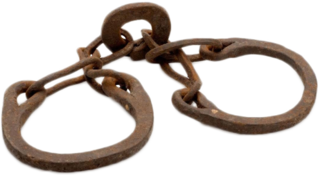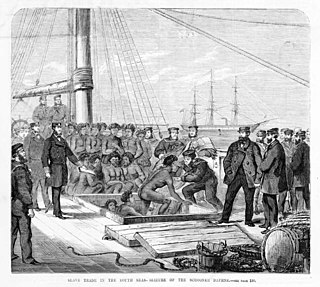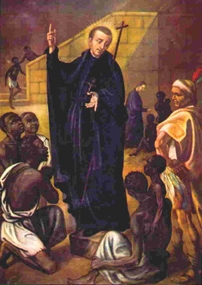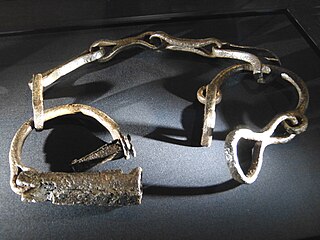 W
WThe history of slavery spans many cultures, nationalities, and religions from ancient times to the present day. Likewise, its victims have come from many different ethnicities and religious groups. The social, economic, and legal positions of slaves have differed vastly in different systems of slavery in different times and places.
 W
WBlackbirding involves the coercion of people through deception or kidnapping to work as slaves or poorly paid labourers in countries distant to their native land. The term has been most commonly applied to the large-scale taking of people indigenous to the numerous islands in the Pacific Ocean during the 19th and 20th centuries. These blackbirded people were called Kanakas or South Sea Islanders. They were taken from places such as the Solomon Islands, Vanuatu, Niue, Easter Island, Gilbert Islands, Tuvalu, the Cook Islands and the islands of the Bismarck Archipelago amongst others.
 W
WPeter Claver was a Spanish Jesuit priest and missionary born in Verdú who, due to his life and work, became the patron saint of slaves, the Republic of Colombia, and ministry to African Americans. During the 40 years of his ministry in the New Kingdom of Granada, it is estimated he personally baptized around 300,000 people and heard the confessions of over 5,000 slaves per year. He is also patron saint for seafarers. He is considered a heroic example of what should be the Christian praxis of love and of the exercise of human rights. The Congress of the Republic of Colombia declared September 9 as the Human Rights national Day in his honor.
 W
WFor over three centuries, the military of the Crimean Khanate and the Nogai Horde conducted slave raids primarily in lands controlled by Russia and Poland-Lithuania as well as other territories.
 W
WFor over three centuries, the military of the Crimean Khanate and the Nogai Horde conducted slave raids primarily in lands controlled by Russia and Poland-Lithuania as well as other territories.
 W
WDum Diversas is a papal bull issued on 18 June 1452 by Pope Nicholas V. It authorized Afonso V of Portugal to conquer Saracens and pagans and consign them to "perpetual servitude". Pope Calixtus III reiterated the bull in 1456 with Inter Caetera, renewed by Pope Sixtus IV in 1481 and Pope Leo X in 1514 with Precelse denotionis. The concept of the consignment of exclusive spheres of influence to certain nation states was extended to the Americas in 1493 by Pope Alexander VI with Inter caetera.
 W
WThe Dutch East India Company, officially the United East India Company, was a megacorporation founded by a government-directed consolidation of several rival Dutch trading companies in the early 17th century. It is believed to be the largest company to ever have existed in recorded history. It was established on March 20, 1602, as a chartered company to trade with Mughal India in the early modern period, from which 50% of textiles and 80% of silks were imported, chiefly from its most developed region known as Bengal Subah. In addition, the company traded with Indianised Southeast Asian countries when the Dutch government granted it a 21-year monopoly on the Dutch spice trade.
 W
WJewish views on slavery are varied both religiously and historically. Judaism's ancient and medieval religious texts contain numerous laws governing the ownership and treatment of slaves. Texts that contain such regulations include the Hebrew Bible, the Talmud, the 12th-century Mishneh Torah by rabbi Maimonides, and the 16th-century Shulchan Aruch by rabbi Yosef Karo. The original Israelite slavery laws found in the Hebrew Bible bear some resemblance to the 18th-century BCE slavery laws of Hammurabi. The regulations changed over time. The Hebrew Bible contained two sets of laws, one for Canaanite slaves, and a more lenient set of laws for Hebrew slaves. From the time of the Pentateuch, the laws designated for Canaanites were applied to all non-Hebrew slaves. The Talmud's slavery laws, which were established in the second through the fifth centuries CE, contain a single set of rules for all slaves, although there are a few exceptions where Hebrew slaves are treated differently from non-Hebrew slaves. The laws include punishment for slave owners that mistreat their slaves. In the modern era, when the abolitionist movement sought to outlaw slavery, some supporters of slavery used the laws to provide religious justification for the practice of slavery.
 W
WThe Shackles of Memory Association is a non-profit association registered under the Law on Associations of 1901, whose aim is to bring closer to the general public the history of the slave trade, slavery and their modern consequences, in order to promote new partnerships on a fair and respectful basis, between the societies of Africa, the Americas and Europe.
 W
WA slave market is a place where slaves are bought and sold. These markets became a key phenomenon in the history of slavery.
 W
WThe Indian Ocean slave trade, sometimes known as the East African slave trade or Arab slave trade, was multi-directional slave trade and has changed over time. Africans were sent as slaves to the Middle East, to Indian Ocean islands, to the Indian subcontinent, and later to the Americas.
 W
WSaqaliba is a term used in medieval Arabic sources to refer to Slavs and other peoples of Central, Southern, and Eastern Europe, or in a broad sense to European slaves. The term originates from the Middle Greek slavos/sklavenos (Slav), which in Hispano-Arabic came to designate first Slavic slaves and then, similarly to the semantic development of the term in other West-European languages, foreign slaves in general. The word was often used to refer specifically to Slavic slaves, but it could also refer more broadly to Europeans traded by the Arab traders.
 W
WSlave raiding is a military raid for the purpose of capturing people and bringing them from the raid area to serve as slaves. Sometimes seen as a normal part of warfare, it is nowadays widely considered a crime. Slave raiding has occurred since antiquity. Some of the earliest surviving written records of slave raiding come from Sumer.
 W
WQuasi-state-level jihadist groups, including Boko Haram and the Islamic State of Iraq and the Levant, have captured and enslaved women and children, often for sexual slavery. In 2014 in particular, both groups organised mass kidnappings of large numbers of girls and younger women.
 W
WSlavery had already existed in Ireland for centuries by the time the Vikings began to establish their coastal settlements, but it was under the Norse-Gael Kingdom of Dublin that it reached its peak, in the 11th century.
 W
WThe Swedish slave trade mainly occurred in the early history of Sweden when the trade of thralls was one of the pillars of the Norse economy. During the raids, the Vikings often captured and enslaved militarily weaker peoples they encountered, but took the most slaves in raids of the British Isles, Ireland and Slavs in Eastern Europe. This practice lasted in the 6th through 11th centuries until formally abolished in 1335. A smaller trade of African slaves happened during the 17th and 18th centuries, around the time Swedish overseas colonies were established in North America (1638) and in Africa (1650). It remained legal until 1813.
 W
WTrade beads are beads that were used as a medium of barter within and amongst communities. They are considered to be one of the earliest forms of trade between members of the human race. It has also been surmised that bead trading was one of the reasons why humans developed language.
 W
WIn the Middle Ages, the Volga trade route connected Northern Europe and Northwestern Russia with the Caspian Sea and the Sasanian Empire, via the Volga River. The Rus used this route to trade with Muslim countries on the southern shores of the Caspian Sea, sometimes penetrating as far as Baghdad. The powerful Volga Bulgars formed a seminomadic confederation and traded through the Volga river with Viking people of Rus' and Scandinavia and with the southern Byzantine Empire Furthermore, Volga Bulgaria, with its two cities Bulgar and Suvar east of what is today Moscow, traded with Russians and the fur-selling Ugrians. Chess was introduced to Old Russia via the Caspian-Volga trade routes from Persia and Arabic lands.
 W
WWife selling is the practice of a husband selling his wife and may include the sale of a female by a party outside a marriage. Wife selling has had numerous purposes throughout the practice's history; and the term "wife sale" is not defined in all sources relating to the topic.